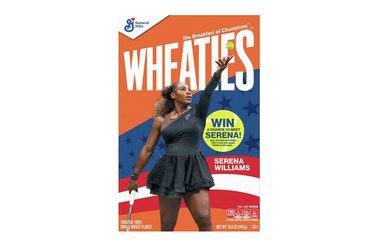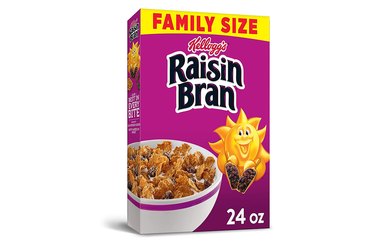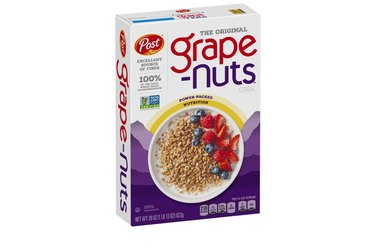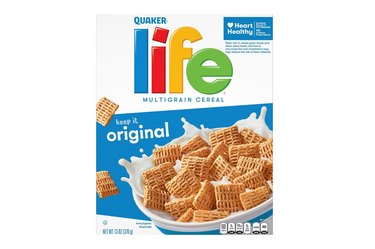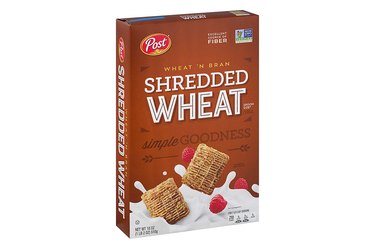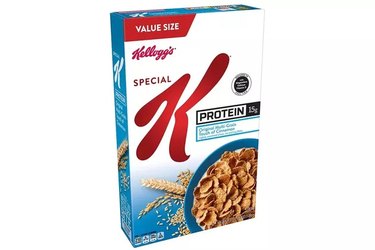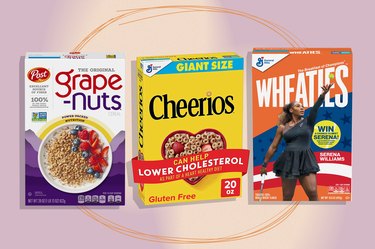
Some varieties of cereal have more fat than others. If you're looking for a low-fat cereal to add to your morning routine, dietitians suggest going with one that's fortified with other vitamins and minerals you need.
Even granola cereals can be high in fat. Other cereals, such as chocolate or fruit-flavored varieties, are often high in fat and may have as much as 30 grams of sugar in a serving.
Video of the Day
Video of the Day
But don't let that turn you off to cereal as a nutritious breakfast choice. Many cereals are high in fiber and are fortified with essential vitamins and minerals.
Below, we share a few low-fat cereal options that taste great and offer many of the nutrients you need.
Tip
Get creative with your low-fat cereal to make it a more well-rounded breakfast. Add fruit for sweetness and more vitamins and minerals. Swap milk for plain Greek yogurt or soy yogurt to up the protein. Stir in your favorite nut butter for protein and healthy fats.
The Best Low-Fat Cereals to Buy
- Wheaties ($6.79, Target)
- Raisin Bran ($3.99, Target)
- Grape Nuts Flakes ($4.99, Amazon)
- Shredded Wheat ($3.89, Target)
- Life Original ($3.99, Target)
- Cheerios ($3.79, Target)
- Special K Protein Original Cereal ($4.68, Walmart)
How We Chose
In our search for the best low-fat cereal products, we spoke with a registered dietician for her recommendations and input. We narrowed down our top picks based on the following criteria:
- Fat content
- Sugar content
- Fiber content
- Ingredients
1. Wheaties
- Total fat: 0.5 grams
Wheaties are a favorite among many athletes, and for good reason. Not only is this cereal low in fat, but it's made with whole-grain wheat, which is full of fiber and B vitamins, and its fortified with a list of other nutrients.
A 1-cup serving of Wheaties only contains 1/2 gram of fat. The same size serving also gives you 4 grams of fiber and only 5 grams of sugar.
Wheaties are fortified with additional nutrients such as zinc, iron, calcium and vitamins A and C. A serving of Wheaties provides 70 percent of your daily iron needs and about 20 percent of your daily needs for zinc.
Buy it: Target.com; Price: $6.79
2. Raisin Bran
- Total fat: 1 gram
While this cereal does have some sugar, "it only has 1 gram of fat in a serving, and it tastes delicious," Glover says. Beyond being low in fat, she adds that it's an excellent source of fiber, providing 7 grams per serving.
The bran flakes are crispy and toasty and each spoonful of cereal has raisins for added sweetness. On top of that, each serving gives you some potassium and 5 grams of protein.
Buy it: Target.com; Amazon ($4.39 for a 24-ounce box)
3. Grape-Nuts Flakes
- Total fat: 1 gram
Start off your morning with this low-fat and filling cereal option. Each serving only has 1 gram of fat and it's another low-sugar option, perfect for customizing with your favorite fruit.
"This cereal is also an excellent source of fiber, and it has 6 grams of protein and no added sugar," Glover says. For each half-cup, you'll get 7 grams of fiber as well as some B vitamins, like folic acid and vitamin B6.
4. Life Original
- Total fat: 1.5 grams
Glover recommends Life's Breakfast Cereal because it only has 1.5 grams of fat, none of which is saturated fat. "It is also a good source of fiber, and a variety of nutrients," she says.
Each square in Life cereal is full of whole grains. Eating more whole grains has been linked to a reduced risk for heart disease, according to the Heart Foundation. Whole-grain ingredients like whole-grain oat flour and wheat flour give this cereal B vitamins, and it's fortified with calcium and iron. Add some berries to your bowl for anti-inflammatory benefits.
Buy it: Target.com; Price: $3.99
5. Cheerios
- Total fat: 2.5 grams
Cheerios is a beloved low-fat breakfast cereal that's also low in sugar, and you can feel good about starting your day with a bowl. The Mayo Clinic recommends choosing a breakfast cereal that is made with whole grains, and the first ingredient in this cereal is whole-grain oats.
On top of that, a serving of plain Cheerios only contains 2 grams of sugar, and they're a good source of fiber, providing about 10 percent of your daily needs. Keep in mind that this cereal comes in a variety of flavors. Flavored Cheerios have similar amounts of fiber and are also low in fat, but some have more sugar.
6. Wheat'n Bran Shredded Wheat Cereal
- Total fat: 1.5 grams
Post Shredded Wheat cereal is low in fat with just 1.5 grams per serving and it contains no added sugar. The Mayo Clinic website recommends Shredded Wheat as a nutritious morning meal because it gives you an impressive 8 grams of fiber per serving and has no added sugar.
Shredded Wheat is fortified with several essential vitamins and minerals, including zinc and folic acid, which increases the overall nutritional value.
Buy it: Target ($3.89)
7. Special K Protein Original Cereal
- Total fat: 1.5 grams
Even though this cereal is slightly higher in sugar than the rest of the options on our list, it's still pretty low and can be a great option if you're looking to occasionally satisfy your sweet tooth. Not only is this cereal low in fat, but as the name suggests, it's fortified with satiating protein, which isn't something you always get with cereal.
A bowl of this cereal serves up an impressive 15 grams of protein, as compared to the 7 to 10 grams other cereals might offer. Thanks to the whole grains, it gives you a helping of nine different vitamins and minerals even offers 8 grams of fiber per serving. On top of that, the subtle hint of cinnamon gives this cereal a yummy taste.
Buy it: Walmart ($4.68)
Things to Consider Before Buying Low-Fat Cereal
Limiting fat in your diet may be important, as it can reduce the risk of many health conditions, such as heart disease. That said, you want to choose a low-fat cereal that supports your health in other ways.
Added Sugar
Many cereal products on the market are high in sugar, even products that are marketed as "healthy." When choosing a low-fat cereal, Glover recommends cereals that contain 8 grams or less of added sugar.
And if you sometimes have a sweet tooth, Glover says it's OK to enjoy the cereals you like in moderation. Enjoy those options occasionally, and stick with lower sugar options on a daily basis.
Fiber
Glover recommends looking for cereals that are high in fiber. Fiber is essential for healthy digestion because it can help you poop and improve your gut health, per the Mayo Clinic.
Most people don't get enough fiber in their diets, but having enough is linked to lower risks of heart disease and other health conditions, according to the American Heart Association.
Other Nutrients
As mentioned, many low-fat cereal products are fortified with nutrients your body needs, such as iron and calcium. Read your nutrition labels to see what other important vitamins and minerals your choices offer.
Glover suggests going with cereals that contain whole-grain ingredients, such as oats and wheat, as these often offer high amounts of B vitamins.
Was this article helpful?
150 Characters Max
0/150
Thank you for sharing!
Thank you for your feedback!
